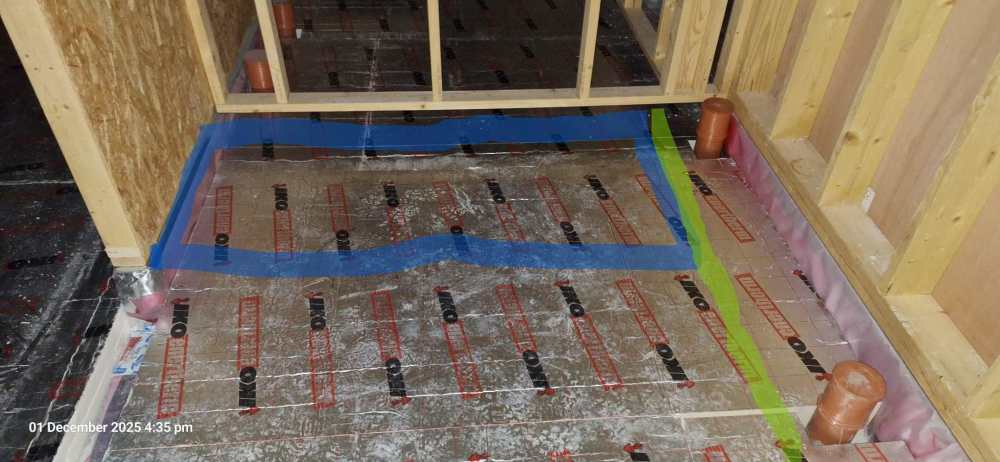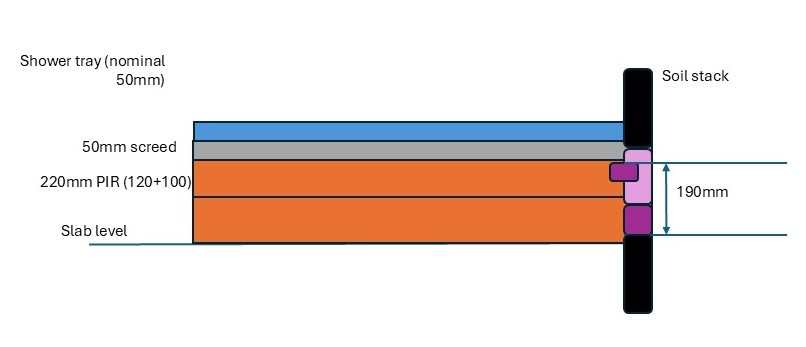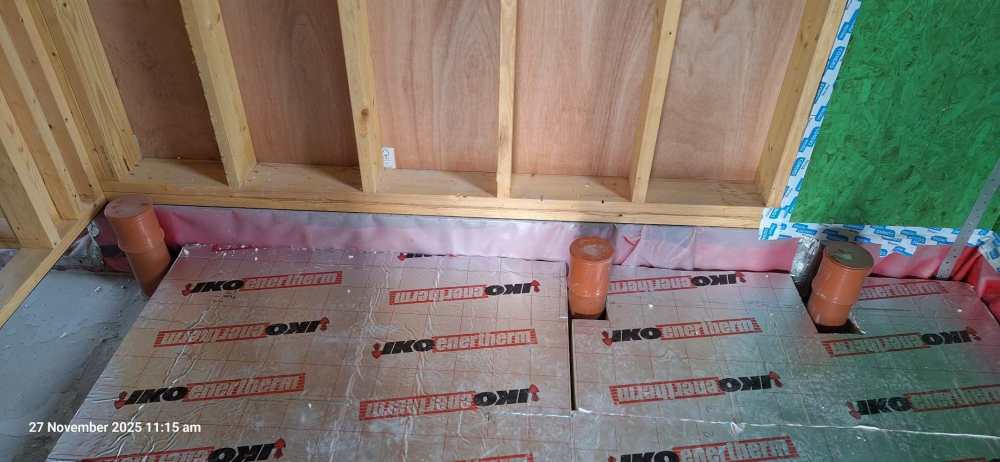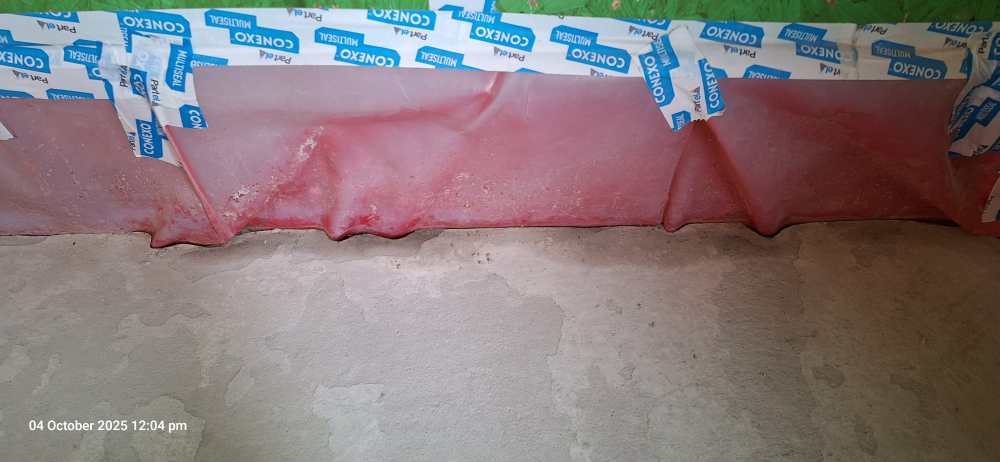
Dunc
Members-
Posts
172 -
Joined
-
Last visited
Everything posted by Dunc
-
Masons mitre or butt joint for solid wood joint
Dunc replied to paro's topic in Kitchen Units & Worktops
+1 on butt joints with biscuits (not glued) and 2 or 3 bolts recessed in the underside. Just a bit of CT1/OB1 at the top of the connecting faces before clamping up. Worked fine on my previous kitchen which had 3 joints in oak worktops. Stainless steel screws in slotted brackets to hold it to the wall or units underneath. -
Perimeter insulation - flooring butted up to or laid over?
Dunc replied to Dunc's topic in General Construction Issues
Will have to wait until its all in and get the laser level on it, but looks like +/- 5mm at the moment, so not disastrous! -
Perimeter insulation - flooring butted up to or laid over?
Dunc replied to Dunc's topic in General Construction Issues
I'm well aware of the arguments around thin and thick screeds. There are many excellent discussions on this forum covering the subject. We're going at 50mm (architect was pushing for 40mm!). The PIR is already on site and the first layer (120mm) installed so rightly or wrongly, we're fully committed. I would, in retrospect, have preferred 70mm to allow better tolerance of the uneven slab but we are where we are and I'm sure it'll work out. Everyones thoughts and recommendations have been much appreciated as always! -
Perimeter insulation - flooring butted up to or laid over?
Dunc replied to Dunc's topic in General Construction Issues
@Gus Potter thanks for looking at the other details. The load transfer is on the inner leaf, aparantly. Vertical timber cladding has 20mm vertical battens then 42mm horizontal so there should be plenty ventilation. -
Hopefully a quick one: When installing the PIR floor insulation a 50mm perimeter upstand is specified. In one of the architects diagrams the upstand stops level with the screed and the final floor covering oversails this to butt up aginst the wall. In another diagram the perimeter upstand extends high enough for the floor covering to be separated from the outisde wall. As this is a larsen truss frame, the inner sole plate is effectively insulated from the outside as it doesn't span the full width of the wall. The blockwork underneath the sole plate has a course of Marmox blocks below the top block and this will overlap with the 220mm PIR, so the top block is thermally broken from the ground....so I *think* it's OK to oversail the upstand? Top to bottom: Tiles 50mm screed with UFH. Top of screed is level with the bottom of the sole plate slip membrane 220mm PIR 150mm reinforced slab.
-
Ground floor shower tray support over insulation
Dunc replied to Dunc's topic in Bathrooms, Ensuites & Wetrooms
@Nickfromwales huge thanks for the detailed decription! Screed in the next couple of weeks but shower tray not for months; just want to make sure I don't do something now that I regret later. Rest of first fix is coming down from above so no problems there, ta. Are the concrete screws those black ones horizontally through the blue expansion skirt? In my case the shower will be going in against 2 walls and I'll need to build a third stud wall to separate the soil stack (green line). I was going to shutter off along the edge of the shower tray +50mm. (Only 1 of the 2 layers of PIR is down on the floor in this photo. Next set to go in with staggered joints). So you suggest that this would be fine with just the PIR and self leveling compound topped with flexible tile adhesive - what relative depths? I have 50mm to make up. Given we haven't decided on a tray yet, I am wondering whether leaving out the PIR in this area would be wiser to allow better access for installing the waste, rather than digging it out later. If so, are you suggesting that laying the tray on the added-back-in PIR plus tile adhesive is NOT appropriate in this case? The other "exciting" challenge is that will I have to connnect the 50mm shower waste to the soil stack which is currently just that stub in the top right hand corner. A female/female straight coupler and a boss adapter (such as https://www.screwfix.com/p/floplast-push-fit-3-boss-single-socket-pipe-black-110mm/97309) puts the top of the 50mm boss at 190mm above the bottom of the coupler. With my 220mm PIR + 50mm screed the bottom of my shower tray is 270mm above the slab so I've got 80mm to play with. Even with a shallow waste, say the Macalpine 53mm (https://mcalpineplumbing.com/traps/shower-traps-accessories/90mm-shallow-shower-trap-53mm-high/) and assuming a drain in the long-side of the 1700mm tray (i.e. 1m from the stack) I'd need about 18mm fall so I'd be cutting the stub off with the coupler stopping only 20mm above slab level. Feels tight! Solvent weld boss adaptor may be better here, assuming solvent weld is OK on the brown underground type pipe? But obviously comes with its own risks - one shot to get it right. Any other suggestions? -
Ground floor shower tray support over insulation
Dunc replied to Dunc's topic in Bathrooms, Ensuites & Wetrooms
That was my concern. I initially thought to construct a wooden frame topped with 22mm ply to support the tray from the slab and then stuff insulation underneath. However, the rest of the ground floor is basically 50mm screed (i.e. a mortar-like substance) on the same insulation. So the question could equally be asked: What happens when you sit on a chair? Does the floor dip under the chair legs? Thus the lazy side of me got to thinking could I save a bit of woodwork... It's rather an expensive experiment to give it a go so I thought it best to ask: I'm sure those with KNOWLEDGE (@Nickfromwales) will be along to put me right. -
I will be installing a shower tray on the ground floor. Build up is: 150mm slab 220mm PIR (don't ask - it was supposed to be 300mm EPS but various architectural and construction cockups and this is where we are) Slip membrane 50mm screed. I'll shutter off the entire shower tray area before the screeding is done (because SWMBO hasn't finalised a desicion on which shower tray so I don't know where the waste will go). Is it reasonable to just lay the tray on a 50mm bed of mortar straight on the membrane & PIR? Could I get away with a thinner mortar bed (if so how thin?) to drop the tray closer to tile level?
-
Well done on a big step! Best thing that happened on our site was putting down a good layer of MOT1 to control the mud. Thought it might have been an "unnecessary" expense at the time but very glad our groundworker did it. I never got round to building a porch for the caravan and TBH don't miss it as much as I'd expected to, though I appreciate many others have done a porch and found it useful.
-
Problem is I have no way to know what they used and they have no inclination to be specific (unfortunately they've already been paid). "We've been doing this 19 years and never had a complaint" type of response. The adhesive seems extremely strong so I'm concerned that ripping it out might not go well... It was selected because I have a timber frame with cellulose fill so it would be advantageous to ensure any moisture that gets in can escape. Certainly the window is sealed inside with airtight tape and the void filled with foam so the cold bridge is dealt with and the internal vapour barrier is as good as anywhere else in the structure. It does seem to have occured only with very strong wind-driven rain. There has been plenty of more "normal" rain which hasn't been a problem so perhaps addition of the cladding will suffice. I have added some temporary OSB "cladding" to see how that goes. Just need another Scottish Hoolie to try it out. Terrifying to think that if this had been done over summer the cellulose fill would already have been pumped in and I'd never have known until it rotted. Maybe being way behind schedule has some silver linings 🙄
-
Ah. No idea what brand or dimension was used. Definitely soft and squishy Sounds like it needs replacing.
-
As title, really. Is Compriband supposed to be 100% (for want of a better term) waterproof? Does it need anything like silicone in addition? My windows are fitted with a ribbon of Compriband to seal against the reveal at the outside. This is in a timber frame, with the window set back 90mm back from the face of the kit. I dont have the timber cladding in place around all of them yet. After yesterday's fierce winds and pretty much 24hrs of rain I have water running in at one of the windows. The windward side Compriband is sopping wet; water can be squeezed out when puching it with a finger tip. I can't see the back of it as the airtightness membremane is already in place on the inside, but this makes me wonder if this is how the water got in. Rather concerned to have to rely on the cladding and reveal boards for waterproofness!
-
Soil stack to male stub - double femal connector OK?
Dunc replied to Dunc's topic in Waste & Sewerage
Thanks guys. I do appreciate the moral support (i.e. pull up your big boy pants and get on with it) @Oz07 😀 Having said that, the solvent weld option looks less risky. Inspection of the pushfit does show that the downstream male end will simply be in the center of the fitting against the small stop tab, but there is no lip so nothing but air pressure preventing contents sliding down the outside of the male pipe's chamfer. Unless I'm mistaken, the caps that the groundworks guys left are a single piece. Will have another look at them though, thanks @Onoff The bend at the bottom is under the MOT and slab so well beyond my ability to inspect it 20 times a day like I do with most of my other "worry-it-might-not-be-tight-enough" jobs 🤣 -
I have a 110mm male stub sticking up through my slab from the rest bend under the slab (currently covered with a femal blanking cap). I need to connect the soil stack to this. Is it OK to use a female/femal push-fit double socket (e.g. https://www.screwfix.com/p/floplast-push-fit-double-socket-pipe-coupler-black-110mm/47977) at the bottom of the stack? Just a little concerned about the stack contents falling the height of the house, hitting the male end with some force and escaping the rubber seal...but can't see another way of doing it? (soil stack on the left - the other 2 are for sink & toilet which I guess will also have to be female/female connectors)
-
My garage door installer placed 25mm battens under the joists to allow the door to be fitted now. He is confident that we will be able to take them out (one side at a time) and slide a double layer of plaster boards in later. As its the garage I think I'll just tape and fill, rather than skim.
-
I'd expect the architect to sort the threshold and FFL. Ideally you'd decide what your floor covering is likely to be so that the architect can make appropriate allowance. eg. ours allowed 22mm for porcelain tiles (+ grout & mat). If you were planning LVT maybe you'd need a lot less. If you don't know yet, best to be conservative (larger allowance) and make it up in screed later if needed. Given your fairly unique situation I'd have thought MBC could generate something generic and allow the architect to sort out the detail before coming back to a second iteration. However, I don't understand how you can have construcion drawings without all the details from someone (usually the architect) that will affect the construction, e.g. where waste pipe runs are (need this for the foundation as a minimum), where you might need to run MVHR ducts (can affect structural members in floors/roofs), what your external cladding is, roof covering, etc etc.
-
OK thanks guys! Sounds like free choice but a clear recommendation for sturdy stuff for the MVHR, and obs. the 110mm plumbing needs to be very solid (no pun intended). Got about half the ducting in today - @Jolo's picutre is very apt. I will say thank goodness for Posi-Joists. I can't imagine the pain of trying to do this and having to cut holes in the right place as well...we were very close to having I-beams so I feel rather fortunate that didn't happen!
-
Paving looks great! How did you create the upstand underneath the windows (the ones without the step)?
-
I have a vague recollection of reading on here somewhere that regulations for strapping pipes and ductwork inside internal walls or between ceiling joists had changed (maybe recently, maybe Scotland only?). Unfortunately my Google-Fu isn't up to finding the post. Does this ring a bell for anyone? This is for first fix work including watste water, water feeds, and MVHR in case it matters. Just received the MVHR ducting which came with a generous supply of plastic zip ties. Want to make sure I don't need to use something else (e.g. metal strap band) before I get started.
-
When we saw our van it was just on it's wheels; both interior and exterior doors were all out of alignment and wouldn't close properly if at all. Once levelled up they are OK and functioning, although not perfect. Levelling can make a significant difference; so it's possible what you were told was in good faith. But if it's now levelled up and there's no adjusment to be had on the door frame or hinges then as others have said you may need to go back to the vendor.
-
Great advice from @ProDave there. I did ours this spring with a single 5 ton bottle jack - whatever was cheapest on Amazon. I was working on well compressed hardcore so the jack was stable enough. I tried using blocks and spacers to start with but it turned out to be so much faff I ended up splurging on adjustable tripods. For a couple of hundred£ this made the job soooo much quicker and easier for me (maybe that doesn't bode well for my DIY skills in building a house 🤣). You need the main axles lifted to get the wheels clear of the ground. The jacking points on mine are either side of the wheels. As you have realised you need to put supports under the ends of the van to stop it just tilting too far around the axle while you're doing this. Just whatever you can jam up under there to start with. Once the wheels are off the ground you can work your way along the additional support points (there will be 4-8 along each of the 2 frame members whcih must have supports under them) to get the long-dimension level. These points were marked on the frame, but it's pretty obvious where there will be a vertical member meeting the horizontal frame. Depending on the exposure of your site you may want to make provision for ground anchors. I used four 1m lenghts of angle iron hammered into the ground to chain down the ends of the van. Was very glad of this during recent storms.
-
Roof on and fully functional. Windows in. Basecourse of blocks under the sole plate have been rendered. Only have breather membremane and battens on the walls; timber cladding not done yet. There is some damp at sole plate but I suspect this is water getting behind the breather membremane at windiw level (no cills yet so water puddling where the cill should be) and running down behind the membremane. No evidence of condensation or trickles of water down the radon membremane updstand though.
-
Hadn't thought of condensation! Although the upstand of radon membremane is dry to the touch. Obviously no idea what it was like overnight. No puddles outside.
-
I hope everyone survived the storm! We have some areas of slightly damp concrete around the edges of one room. Can anyone advise if this is a concern? Buildup is Mot1, radon barrier, 150mm reinforced concrete slab. (Eventually there will also be 200mm PIR, slip membremane, UFH pipes and 50mm screed.) I can only imagine that the radon barrier is compromised somewhere around these 2 walls. Only fix I can see is dig up the slab. Which isn't ideal 😞 Other ideas could be lay another dpm over the slab and tape to the existing upstand? Advice greatly appreciated.
-
Sounds like a similar situation to me: Timber frame on blocks. We've just had the blockwork rendered below DPC (well, after they finished I went around with a cold chisel and made damn sure ALL the render finished below DPC, not just "most" of it 🙄). Vertical timber cladding stood off the timber frame ~62mm will hang down ~50mm over the render. We're just leaving it natural colour. I'm concerned that as the render permanantly exposed to damp (wicking up from the ground) any paint may blister off with time...hopefully the render itself won't blister!







